Summer isn’t complete without Fresh Basil Pesto! This classic recipe is made with just the right blend of fresh basil leaves, toasted pine nuts, garlic, and parmesan cheese. Along with olive oil, these 5 simple ingredients make an irresistible sauce for pasta, sandwiches, salads, veggies, and more!
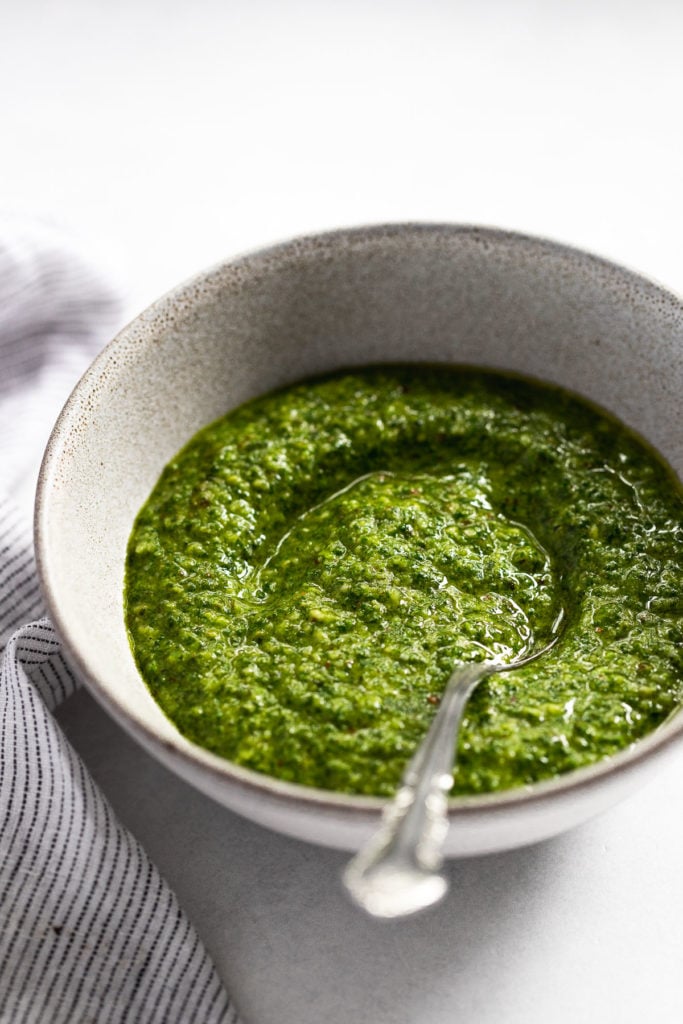
If slathering fresh basil pesto on just about everything in the summertime is wrong, then I don’t want to be right. I can’t resist the fresh, vibrant, and bright homemade sauce that pairs with just about every summer dinner, side, and appetizer under the sun.
Around here, we love easy homemade savory sauces, and this one is no exception, my friends. It takes less than 10 minutes to make (even quicker if you decide to opt-out of toasting the pine nuts) and can be done in a food processor or blender to make life easy-peasy!
Whether your garden is bursting with fresh basil, or you just have a serious hankering for this fresh herb-a-licious sauce, let’s get to cooking. Is it really cooking if you don’t actually have to cook anything? I digress, whatever you want to call it, it’s easy, delicious, and quick to do!
What You’ll Need to Make Basil Pesto
Five simple ingredients are all you need to make fresh pesto, and honestly, many of them have easy-to-make swaps if you don’t have a particular ingredient. It’s truly a beautiful, beautiful thing.
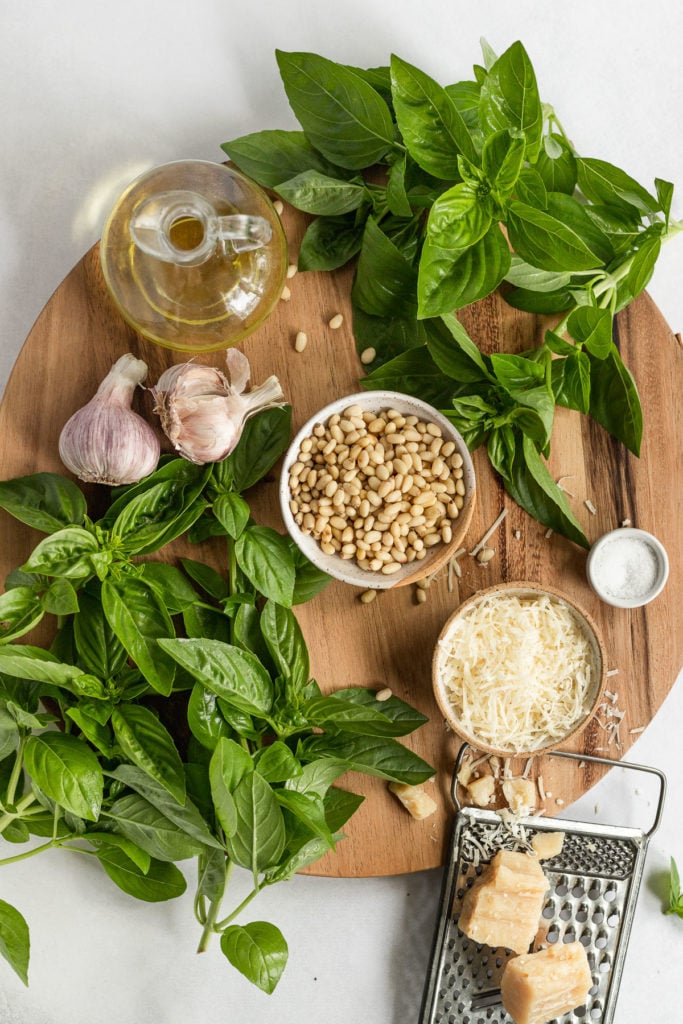
- Fresh Basil – this is a classic basil pesto recipe, so we’re going all in with fresh basil. There are many varieties of basil in the world, but the sweet basil you’ll find in grocery stores is the one you want! Stay away from Thai Basil for this recipe, as it will be too pungent. Did you know that there are many varities of pesto out there that are adapted to include various herbs and/or greens, so if you’re short on basil, you might want to consider adding some fresh mint too (or parsley!). Keep reading for more basil tips, like how to store it before using!
- Pine Nuts – their buttery texture and mild nutty flavor make the perfect addition to basil pesto, and give it its smooth, silky texture. However, because they come from pine cones and are quite time-intensive to harvest, they are the most expensive nuts out there. If you’re not quite ready to splurge, you can easily substitute walnuts or almonds in their place.
- Garlic – there’s no sauce recipe I would make without garlic TBH, but fresh garlic in pesto is key. It adds so much flavor and a bit of pungent flavor to the sauce (in a good way). Add more or less, depending on your tastes.
- Parmesan Cheese – nothing compares to the salty, nutty bite of parmesan cheese in pesto. You can use Romano if you’re looking for a more bold cheese flavor, or omit the cheese entirely if you’re dairy-free or would like a vegan pesto. I highly recommend freshly shredding your parmesan for best results and flavor!
- Olive Oil – a key component of pesto, using high-quality olive oil will give your sauce the most flavor. If I’m serving the pesto raw, I’ll definitely break out the highest quality olive oil in my cupboard. If, however, I know I’ll be cooking it like in a pasta, I’m more inclined to use my everyday olive oil.
Fresh Basil Tips
CHOOSING FRESH BASIL
When you’re choosing fresh basil for recipes or garnish, look for bright green leaves that are not bruised. You don’t want any dark areas on them, and they shouldn’t be too droopy.
HOW TO STORE FRESH BASIL
Similar to flowers, trim the ends off of the large stems of fresh basil and place the tip of each stem in a small glass of water. Store the basil in the cup at room temperature for best results. The basil should last several days or more on the counter this way, just change the water every so often. Fresh basil in my garden can last a week or more (if I don’t get my hands on it before then!)
How to Make Pesto
And, I present to you, an incredibly easy sauce recipe that is going to change your summer dining game. Are you ready for it?
To start, grab your food processor or blender. Either will work for this recipe. If you have a larger food processor (like my 14-cup one pictured here), you may need to scrape the sides more – or double the recipe – to make sure the ingredients are well combined.
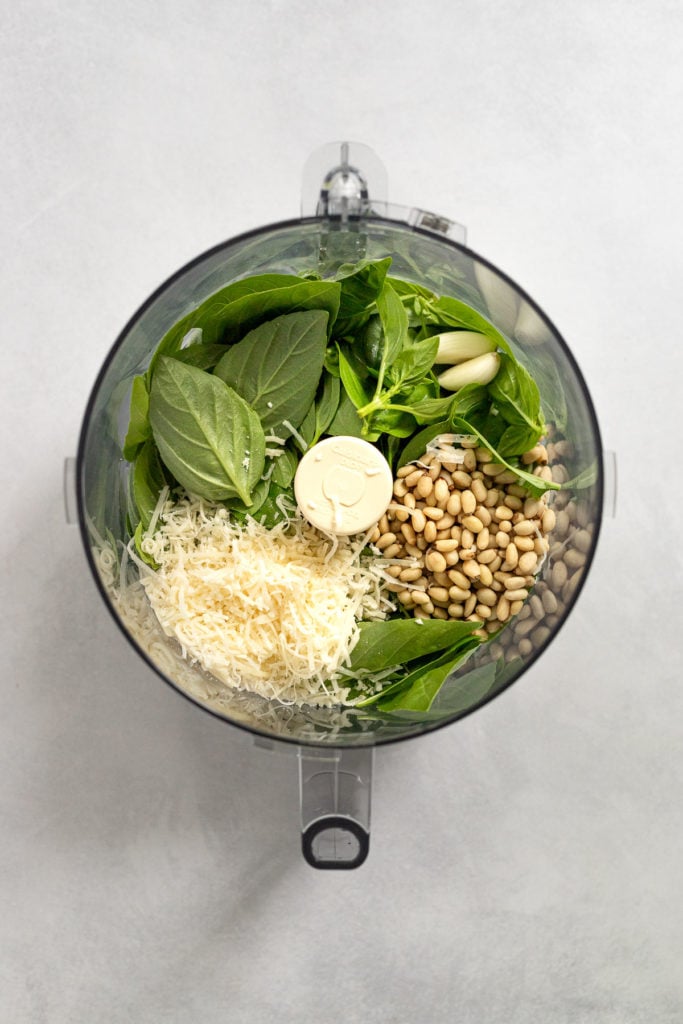
Start by pulsing together all ingredients except for the olive oil. In goes the fresh basil, garlic cloves (you can absolutely just add them whole!), parmesan cheese, and pine nuts.
I also like to add a bit of salt here, but remember to taste test after you mix it together and adjust as needed. The parmesan adds some salt but you will likely need more.
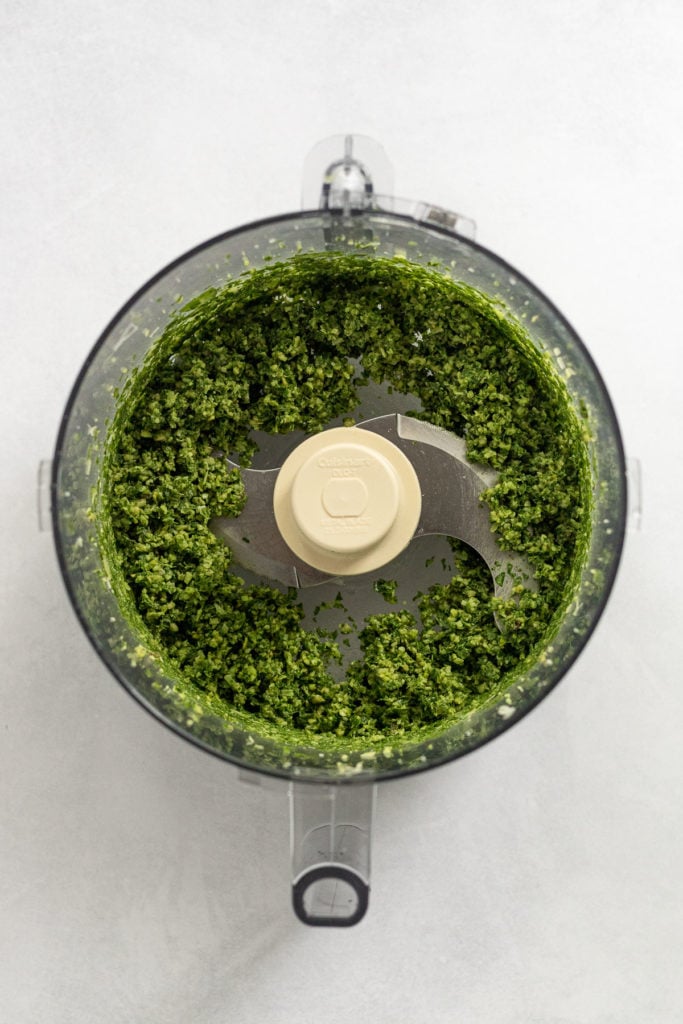
Once those ingredients are pulsed together and are a medium to a fine mixture, begin drizzling in the olive oil while the food processor is running. Slowly drizzling it in helps the sauce emulsify and combine, creating a smooth luxurious sauce.
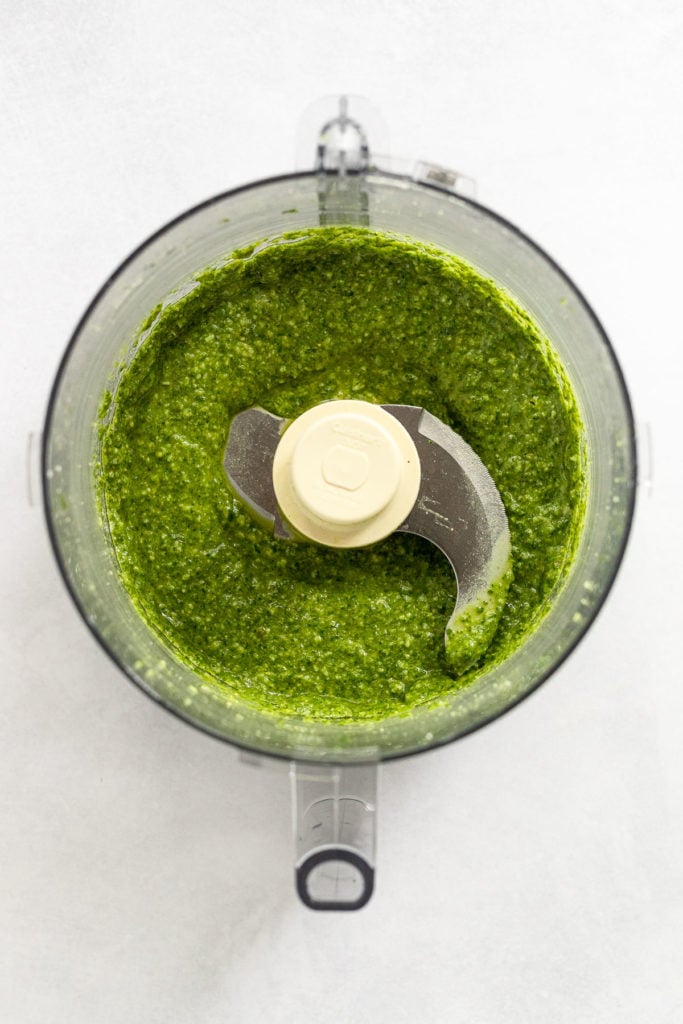
It’s worth mentioning again, taste test for salt levels, adjusting those and/or the parmesan or olive oil as desired. If you want a smoother sauce, pulse in more olive oil. For a cheesier version, add in more parmesan. At this point, you can absolutely play around with it and make it what you want!
Variations
There are so many variations to homemade pesto, and half of the fun is expanding on it and experimenting!
- Herbs + Greens: add in a handful of another herb like parsley, mint, or chives. You can also add in spinach, kale, or carrot tops for a delicious and nutritious take on pesto.
- Nuts: as I mentioned, if you’re not looking to shell out on pine nuts, or you simply have another nut on hand you’d rather use, go for it! I like almonds or walnuts as a substitute in pesto.
- Cheese: try Pecarino Romano or Asiago…or simply leave out the cheese to make a dairy-free and vegan version of pesto.
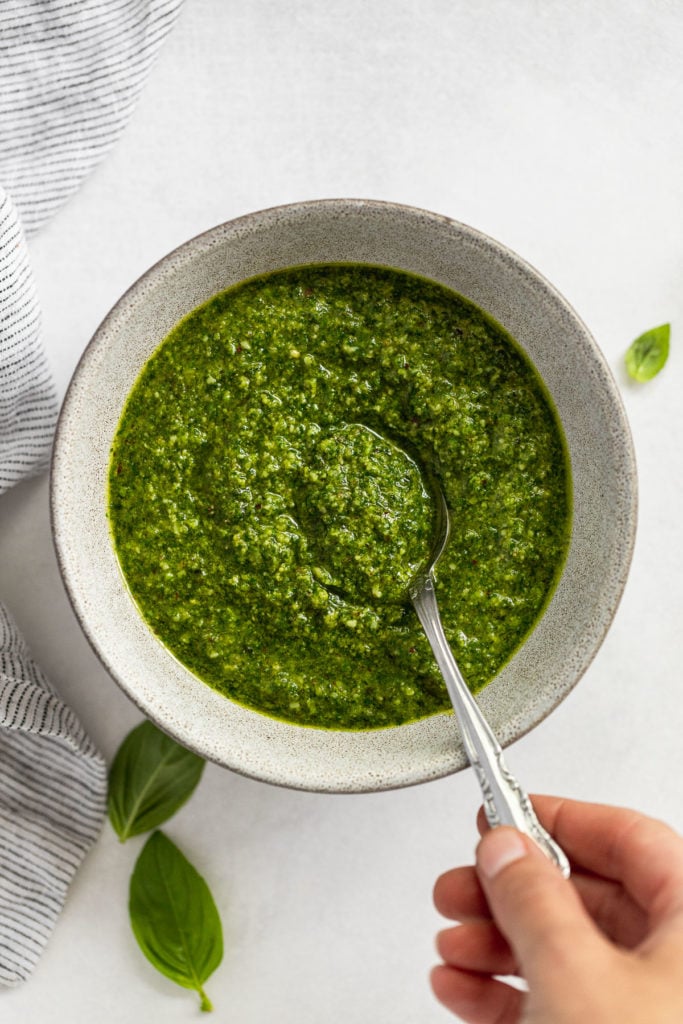
Ways to Use Pesto
Oh, let me count the ways I love to use pesto! There are so many delicious ways to use this magical sauce, and even better? Many of them include pairing it with fresh summer produce. The combination is unlike any other.
Of course, one simply magical way is to use it in pasta.
- Like this Salmon Pesto Pasta with Corn
- Toss it with gnocchi
- Use it in pasta salad with veggies and cheese
There are also endless ways to use it as an appetizer.
- Make a creamy baked cheese dip with pesto and sun-dried tomatoes (MY FAV)
- Layer it with roasted tomato jam and burrata cheese
- Add it to a cheese board, dip baguette slices in it, or spread it on crackers
- Add it to bruschetta or make a caprese salad with pesto
Of course, I love pesto on summer flatbreads.
- Like this fresh, sweet, and savory Grilled Peach, Pesto, and Burrata Flatbread
- Mediterranean Flatbread Pizza has all the flavors!
- When summer produce is a plenty, make this Grilled Corn, Burrata, and Pesto Flatbread
- Easy Bruschetta and Burrata Flatbread has all the classic tomato and basil flavor combos
- And you know it’d be amazing drizzled on top of a margherita flatbread
You can literally do anything with pesto. Drizzle it on top of roasted veggies, bake it into a quiche, spread it on top of pan seared fish or a protein of choice, or add it to a sandwich for a burst of flavor. There are endless possibilities and I can’t wait to hear how you enjoy it!
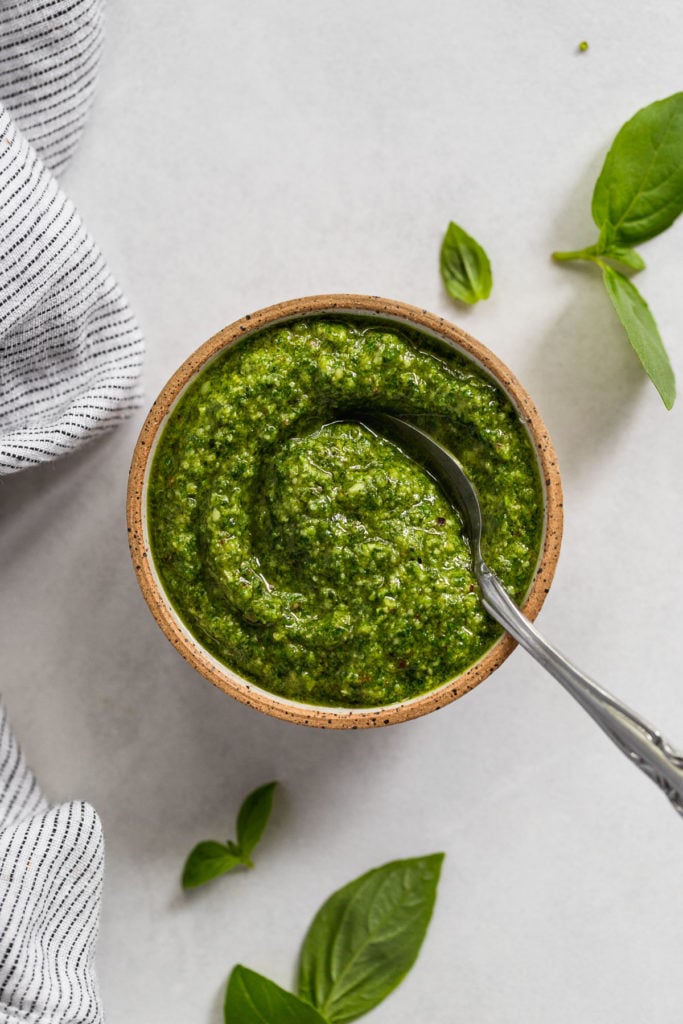
FAQs
Yes, you can! Pesto will oxidize as it sits, so if making it ahead of time cover with a thin layer of olive oil or plastic wrap to help slow down this process.
Store pesto in an airtight container, preferably a jar its size to prevent oxidation. Add a thin layer of olive oil on top or plastic wrap pressed against the top for best results. It will keep in the fridge for about 5 days (if it lasts that long!).
Yes, you can! I like to freeze pesto in a Souper Cube tray or an ice cube tray to make it easy to use when I need some. If you’re worried about the cheese and freezing, you can make the pesto without the cheese and add it in once you’ve thawed the pesto and are ready to use it.
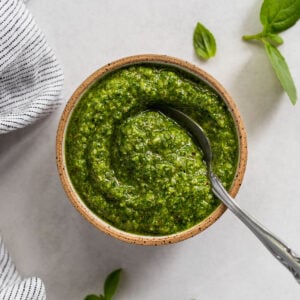
Get the Recipe Fresh Basil Pesto
Ingredients
- 2 cups tightly packed fresh basil leaves
- 1/4 cup pine nuts, optional: toasted
- 3 garlic cloves
- 1/2 teaspoon fine sea salt, or to taste
- 1/2 cup parmesan cheese, freshly shredded
- 1/2 cup extra virgin olive oil
Equipment
Instructions
- In the bowl of a food processor with a chopping blade (or blender), add the basil leaves, pine nuts, garlic cloves, salt, and parmesan cheese. Pulse until finely chopped together. If you want to use toasted pine nuts, place them in a small skillet over low-medium heat for 3-4 minutes until warm, fragrant and toasted.
- While the food processor is running, slowly drizzle in the olive oil, scraping the sides of the bowl as needed. Taste test for salt levels and adjust as desired.
- Pesto is ready to use immediately, otherwise store it in an airtight container in the fridge for up to 5 days. You may want to cover with a thin layer of olive oil or plastic wrap to prevent oxidation.
Notes
By the Way…
This recipe is part of our collection of savory homemade sauce recipes. Check it out!

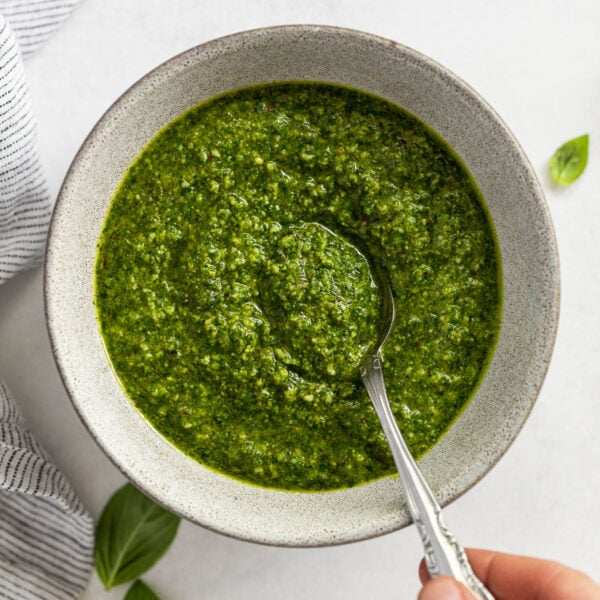




Could I sub toasted pecans for the pine nuts? I love basil in any shape or form. Can’t wait to make this!
Hi Judy – you absolutely can! Enjoy!!